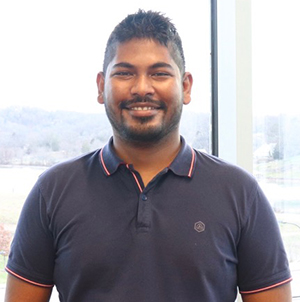Shull Wollan Center Graduate Research Fellowship for Hasitha Suriya Arachchige

Physics Graduate Student Hasitha Suriya Arachchige has spent the spring term researching magnetic materials with support from a prestigious Shull Wollan Center Graduate Research Fellowship.
The Shull Wollan Center (SWC) is a partnership between UT and Oak Ridge National Laboratory (ORNL) that draws on their collective expertise and resources to advance neutron science in terms of discovery, industry, and education.
Suriya Arachchige is working with Professor David Mandrus of UT Materials Science and Engineering and Andrew Christianson of ORNL to study the possibility of topological spin textures in centrosymmetric magnetic structures. Spin is an intrinsic property, the same as charge or mass, which is responsible for the ferromagnetism and its multiple applications. Like the pixels of an image, the electronic spins can form different textures. When all spins point in the same direction, we say that the material is a ferromagnet. However, there are other types of magnets in which the spins form more complex patterns known as “topological spin textures.” The defining characteristic of these textures is that certain properties are robust under smooth deformations of the spin pattern: twisting or stretching won’t affect its properties. In the literature, such spin systems were predominantly found in non-centrosymmetric magnetic structures. However, recent theory guidelines have indicated the possibility of topological spin textures in centrosymmetric magnetic structures. (One of the theorists involved in proposing such criteria is UT Lincoln Chair Professor of Physics Cristian Batista.)
Suriya Arachchige explained that investigating these new possibilities in magnetic materials gives researchers a deeper understanding about the requirements and limitations in hosting topological spin textures, whose manipulation is one potential route to develop next-generation electronics. Neutron scattering plays a key role in his work because it’s the best technique to probe the magnetism of bulk materials at an atomic scale. The resources of the Spallation Neutron Source (SNS) and High Flux Isotope Reactor (HFIR) at ORNL provide a major advantage for UT students interested in this research area.
A native of Homagama, Sri Lanka, Suriya Arachchige earned a bachelor’s degree in physics from the University of Colombo in 2014 and began his graduate studies at UT in 2015. He started working with Mandrus and Christianson in 2016 and has co-authored papers in Physical Review Letters, Physical Review B, and Physical Review Materials. The research fellowship, awarded in January, provides $12,000 over six months to support his efforts. These awards recognize and support outstanding UT doctoral students engaged in neutron scattering research.
The department has close ties to the SWC: Professor Cristian Batista is the Deputy Director and Director Alan Tennant is a joint faculty professor. Learn more about the center by visiting their website.